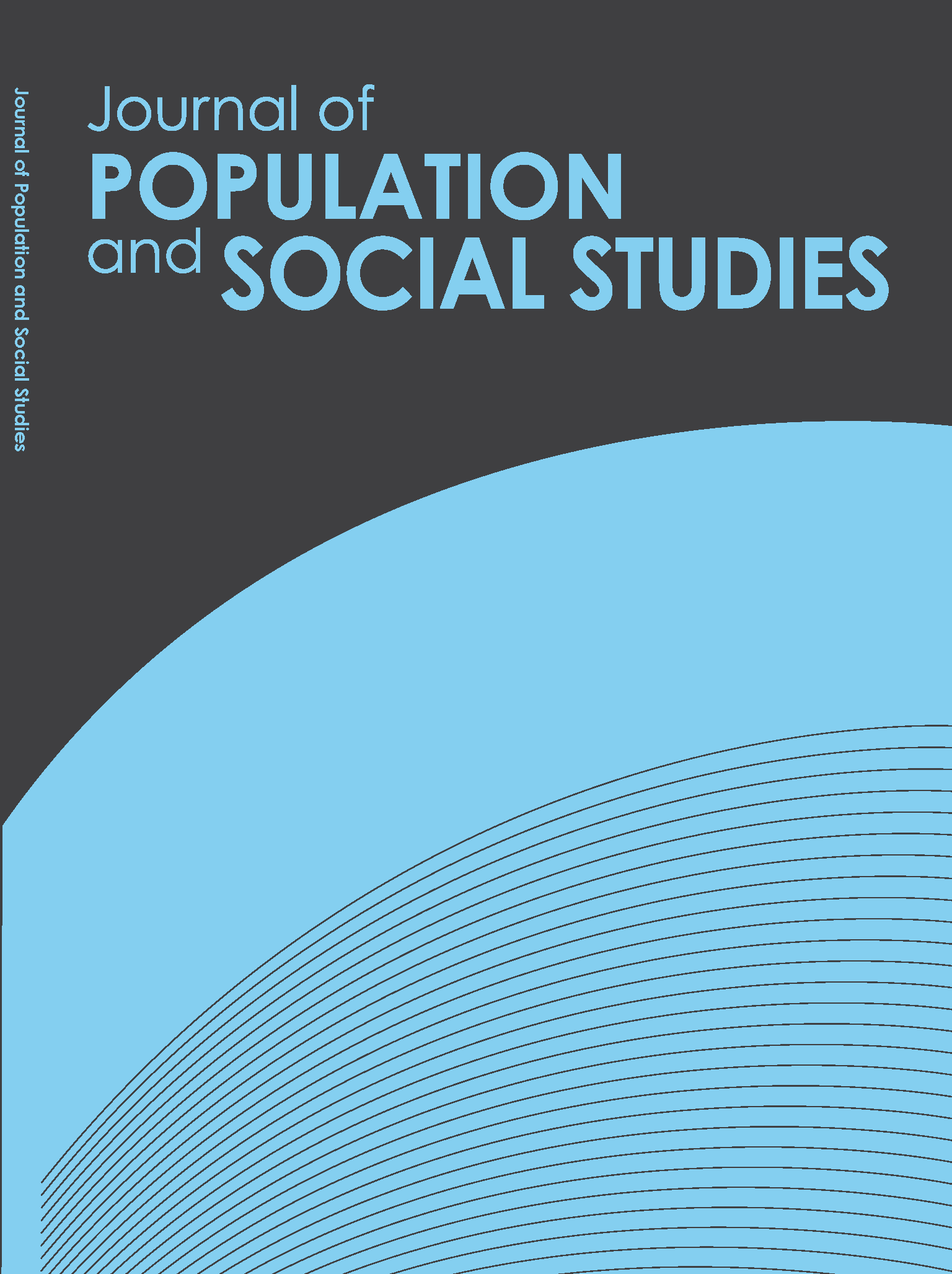Causality among Savings, Income and Longevity: Empirical Evidence from Thailand
Main Article Content
Abstract
Savings is very important to Thailand’s economic opportunity in an ageing society since it is considered to be an intergenerational transfer to finance the older population’s consumption after retirement. This study examines the causal relationship among savings, income and longevity in Thailand during 1960 – 2012 by employing Vector Autoregression Analysis and the Granger Causality Test. In this study, savings is measured by two indicators, real gross domestic savings per capita and gross domestic savings rate, whereas income and longevity are measured by real gross domestic product per capita and life expectancy at birth, respectively. The findings reveal that there is a unidirectional causality running from income and longevity to savings per capita in Thailand while there is a unidirectional causality running from only longevity to the savings rate of Thai people. Additionally, there is evidence of a bi-directional causality between income and longevity. However, there seems to be no causality running from savings per capita to either income or longevity and no causality between the savings rate and income.
Article Details
References
Aghion, P., Comin, D., Howitt,P. & Tacu, I. (2009). When does domestic saving matter for economic growth? (Working Paper No.09-080). Cambridge, MA: Harvard Business School, Harvard University. doi: 10.3386/w12275.
Agrawal, P. (2001). The relation between savings and growth: Cointegration and causality evidence from Asia. Applied Economics, 33, 433 – 513. doi: 10.1080/00036840122210.
Bloom, D.E., Canning, D. & Graham, B. (2003). Longevity and life-cycle savings. The Scandinavian Journal of Economics, 105, 319 – 338. doi: 10.3386/w8808.
Breyer, F. & Marcus, J. (2010). Income and longevity revisited: do high-earnings women live longer? (Discussion Paper No. 1037). Berlin: German Institute for Economic Research. Retrieved from https://www.diw.de/documents/publikationen/73/diw_01.c.358682.de/dp1037.pdf
Chansarn, S. (2010). Capitalizing on two demographic dividends and improving the standard of living in Thailand. Journal of Demography, 26, 1 – 21. Retrieved from http://www.cps.chula.ac.th/wp-content/uploads/2013/08/t-journal26-11f.pdf
Chen, W., Clarke, J.A. & Roy, N.(2012). Health and wealth: short panel Granger Causality tests for developing countries. (Econometric Working Paper EWP 1204). Victoria, Canada: University of Victoria. Retrieved from http://www.uvic.ca/socialsciences/economics/assets/docs/econometrics/ewp1204.pdf.
Ciftcioglu, S., Karaaslan,C. & Demir, M.H.(2004). Savings, investment, exports and economic growth in Turkey. Reviews of Social, Economic and Business Studies, 3/4, 20 – 30.
Granger, C.W.J., (1969). Investigating causal relations by econometric models and cross-spectral methods. Econometrica, 37, 424 – 438. doi: 10.2307/1912791.
Gu, X. & Tam, P.S. (2013). The saving–growth–inequality triangle in China. Economic Modelling, 33, 850 – 857. doi: 10.1016/j.econmod.2013.06.001.
Guest, R.S. & McDonald, A.M. (2001). Ageing, optimal national saving and future living standards in Australia. The Economic Record, 77, 117 – 134. doi: 10.1111/1475-4932.00008.
Hansen, C.W. (2012). The relation between wealth and health: Evidence from a world panel of countries. Economics Letters, 115, 175 – 176. doi: 10.1016/j.econlet.2011.12.031.
Ismail, K. & Rashid, K. (2013). Determinants of household saving: Cointegrated evidence from Pakistan (1975–2011). Economic Modelling, 32, 524 – 531. doi: 10.1016/j.econmod.2013.02.004.
Kim, S. & Lee, J.W. (2008). Demographic changes, saving, and current account: An analysis based on a panel VAR model. Japan and the World Economy, 20, 236 – 256. doi: 10.1016/j.japwor.2006.11.005.
Kwack, S.Y. & Lee, Y.S. (2005). What determines saving rates in Korea? The role of demography. Journal of Asian Economics, 16, 861 – 873. doi: 10.2139/ssrn.570002.
Lee, R. & Mason, A. (2006). What is the demographic dividend?. Retrieved from http://www.imf.org/external/pubs/ft/fandd/2006/09/basics.htm.
Li, H., Zhang, J. & Zhang, J. (2007). Effects of longevity and dependency rates on saving and growth: evidence from a panel of cross countries. Journal of Development Economics, 84, 138 – 154. doi: 10.1016/j.jdeveco.2006.10.002.
Kinugasa, T. & Mason, A. (2007). Why countries become wealthy: The effects of adult longevity on saving. World Development, 35, 1 – 23. doi: 10.1016/j.worlddev.2006.09.002.
Mason, A. & Kinugasa, T. (2005). East Asian economic development: Two demographic dividends. (Working Paper No. 83). Manoa, HI: East-West Center. Retrieved from http://www.eastwestcenter.org/system/tdf/private/ECONwp083.pdf?file=1&type=node&id=32063.
Mason, A., Lee, R., An, C.T., Mun, S.L. & Miller, T. (2006). Population ageing and intergenerational transfers: Introducing age into national accounts. (Working Paper No. 12770). Cambridge, MA: National Bureau of Economic Research. doi: 10.3386/w12770.
Mohan, R. (2006). Causal relationship between saving and economic growth in countries with different income levels. Economic Bulletin, 5, 1 – 12. Retrieved from http://www.accessecon.com/pubs/EB/2006/Volume5/EB-05E20002A.pdf.
Park, D. & Rhee, C. (2005). Saving, growth, and demographic change in Korea. Journal of Japanese and
International Economies, 19, 394 – 413. doi: 10.1016/j.jjie.2003.12.005.
Paxson, C. (1996). Saving and growth: evidence from the micro data. European Economic Review, 40, 255 – 288. D doi: 10.1016/0014-2921(95)00063-1.
Pop, I.A., Van Ingen, E. & Van Oorschot, W. (2013). Inequality, wealth and health: is decreasing income inequality the key to create healthier societies? Social Indicators Research, 113, 1025 – 1043. doi: 10.1007/s11205-012-0125-6.
Preston, S.H. (1975). The changing relation between mortality and level of economic development. Population Studies, 29, 231 – 248. doi: 10.1080/00324728.1975.10410201.
Rasmidatta, P. (2011). The Relationship between domestic savings and economic growth and convergence hypothesis: Case study of Thailand. (Unpublished thesis). Södertörn University, Södertörn, Sweden. Retrieved from http://www.diva-portal.org/smash/get/diva2:425833/ATTACHMENT01.pdf.
Said, S.E. & Dickey, D.A. (1984). Testing for unit roots in autoregressive-moving average models of unknown order. Biometrika, 71(3), 599 – 607. doi: 10.1093/biomet/71.3.599.
Sims, C. (1980). Macroeconomics and reality. Econometrica, 48, 1 – 48. DOI: 10.2307/1912017.
Singh, T. (2010). Does domestic saving cause economic growth? A time-series evidence from India. Journal of Policy Modeling, 32, 231 – 253. doi: 10.1016/j.jpolmod.2009.08.008.
Sinha, D. & Sinha, T. (1998). Cart before the horse: the saving-growth nexus in Mexico. Economics Letters, 61, 43 – 47. doi: 10.1016/S0165-1765(98)00144-X.
United Nations. (2012). World population prospects 2012: The 2012 revision. Retrieved from the World Development Prospects website: http://esa.un.org/wpp/unpp/p2k0data.asp.


